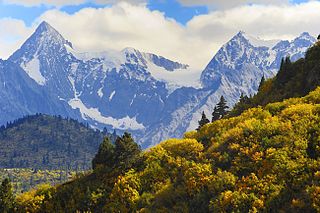
Yadong County, also known by its Tibetan name Dromo/TromoCounty is a frontier county and trade-market of the Tibet region of China, part of its Shigatse Prefecture.

The Lohit River, which name came from the Assamese word Lohit meaning blood, also known as the Zayul Chu by the Tibetans and Tellu by the Mishmis, is a river in China and India, which joins the Brahmaputra River in the state of Assam. It is formed in the Zayul County of the Tibet Autonomous Region, through a merger of two rivers: the Kangri Karpo Chu, which originates in the Kangri Karpo range, and Zayul Chu, which originates to its northeast. The two rivers merge below the town of Rima. The combined river descends through this mountainous region and surges through Arunachal Pradesh in India for 200 kilometres (120 mi) before entering the plains of Assam where it is known as the Lohit River. Tempestuous and turbulent, and known as the river of blood partly attributable to the lateritic soil, it flows through the Mishmi Hills, to meet the Siang (Brahmaputra) at the head of the Brahmaputra valley.

Phari or Pagri is a town in Yadong County in the Tibet Autonomous Region, China near the border with Bhutan. The border can be accessed through a secret road/trail connecting Tsento Gewog in Bhutan known as Tremo La. As of 2004 the town had a population of 2,121. It is one of the highest towns in the world, being about 4,300 m (14,100 ft) above sea-level at the head of the Chumbi Valley.

Dêgê County is a county in southern China, which was formerly one of the Kham region's five independent kingdoms - the Kingdom of Derge - but is now administered as a county in Garzê Tibetan Autonomous Prefecture in far northwestern Sichuan, China, bordering the Tibet Autonomous Region to the west. Its county seat is the town of Derge.

Pasho County or Baxoi County is a county under the administration of Chamdo Prefecture in the Tibet Autonomous Region. The county seat is at Pema, which is also called the Pasho Town. The county population is 35,273 (1999). It contains the Pomda Monastery and Rakwa Tso lake.

Mêdog, or Metok, or Motuo County, also known as Pemako, is a county as well as a traditional region of the prefecture-level city of Nyingchi in the Tibet Autonomous Region of the People's Republic of China (PRC). Pemako is considered famous as the Nyingma master Dudjom Rinpoche's birthplace, and as a prophesied refuge for Tibetan Buddhists by Padmasambhava.

Zayul County (Tibetan: རྫ་ཡུལ་རྫོང, Wylie: rdza yul rdzong, THL: dza yül dzong) or Zayü County is a county in the Nyingchi Prefecture in the southeastern part of the Tibet Autonomous Region, China.
Dzongka or Zongga is a town and the administrative headquarters of Gyirong County in the southwestern Tibet region of China bordering Nepal. Being the administrative headquarters, it is also sometimes referred to as "Gyirong Dzong" or "Gyirong Town", but it is different from the original Kyirong Town in the southern part of the county.

Gertse County, Gêrzê County or Gaize County is a county located in Ngari Prefecture in the northwest of the Tibet Autonomous Region, bordering Xinjiang to the north.
Bêba is a town in the west of Bayi District, Nyingchi, in the southeast of the Tibet Autonomous Region. It lies at an altitude of 3,231 metres along China National Highway 318 from Markam to Lhasa, between Bayi and Kongpo Gyamda. The Niyang River, a tributary of the Tsangpo, flows past the town.
Puqu or Burqug is a township located in the south of Bayi District, Nyingchi, Tibet Autonomous Region, China.
Golag is a township in the northeast of Zayü County, Nyingchi, in the southeast of the Tibet Autonomous Region.

Tramog or Tramo, also called Zhamog or Zhamo in Chinese, is a town and the county seat of Pome County in the Nyingchi Prefecture, Tibet region of China. Being the county seat, it is also referred to as the Pome town or Pomi town.

Heishui County is a county in the north of Sichuan Province, China. It is under the administration of the Ngawa Tibetan and Qiang Autonomous Prefecture. The county has an area of 1,682 square miles (4,356 km2) and its average elevation is 11,627 feet (3,544 m). As of 2016, the county has a population of 61,744.
Shangzayü is a town of Zayü County, in southeastern Tibet Autonomous Region, People's Republic of China (PRC), located in a deep river valley 68 km (42 mi) from the county seat and bordering India's Arunachal Pradesh, which is claimed by the PRC, to the south and west. As of 2003, it has a population of 3002, and as of 2011, it has 16 villages under its administration.
Xiazayü is a town of Zayü County, in southeastern Tibet Autonomous Region, People's Republic of China (PRC), located in a deep river valley 47 km (29 mi) from the county seat and bordering India's Arunachal Pradesh, which is claimed by the PRC, to the southwest, as well as Burma to the southeast.
Daba (Tibetan: མདའ་པ, Wylie: mda' pa; Chinese: 达巴乡; pinyin: Dábā Xiāng) or Danbab (Tibetan: མདའ་འབབ་ཤང, Wylie: mda' 'bab shang, ZYPY: Danbab Xang) is a township under the administration of Zanda County in the Tibet region of China, centred at the Daba village.

Rima is the former capital of the Zayul in the southeastern Tibet Autonomous Region of China. It is on the border with India's Arunachal Pradesh at the confluence of the Rongto Chu and Zayul Chu rivers, which join to form the Zayul River before it flows into Arunachal Pradesh. Rima was a notable border trading town, which the British contemplated as a location for a trade mart in the Lhasa Convention.












